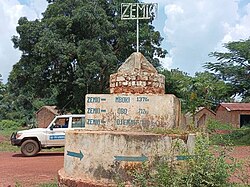History
French Congo colonial government sent five prisoners from Annam to Zemio to work for the French garrison in 1896. The workers planted rice, banana, and tobacco and established a settlement near the town. The prisoners stayed in Zemio until 10 April 1904, when they had to move to Brazzaville. [4] In 1924, a missionary named John Buyse established AIM mission station in Zemio. [5]
In the 1970s, Zemio was the center of the illegal ivory trade. [3]
Central African Republic Civil War (2012-present)
In May 2014, Anti-balaka militia from Bahr attacked Zemio. [6] From 18 to 21 November 2014, a sectarian clash between Muslims and Christians ensued in Zemio, resulting in two people dead, two missing, and 15 injured. Thirty-eight houses were burned in Mama 1 neighborhood. [7]
On 28 June 2017 Ugandan forces withdrew from Zemio. Armed Muslims entered town, killing at least 28 civilians. [8] As of January 2021 Zemio remains under control of Union for Peace in the Central African Republic rebel groups. [9]
FACA and Wagner mercenaries from Bangui and Obo arrived in Zemio on 25 May 2024 after more than six years. [10]
The town's residents held a demonstration against the arrest of several individuals who were accused of getting involved in the violence on 3 April 2025. The protestors dispersed after FACA soldiers fired into the air. Due to the demonstration, shops were closed. [11] Responding to the demonstration, a joint MINUSCA-FACA patrol was formed to restore order. [12]
Economy
Agriculture is the main source of income for the town residents. Other than that, some town residents engage in fishing, hunting, and honey-gathering activities for their livelihood. [15] As of August 2023, Zemio is considered the most expensive city in Central African Republic. One bag of flour and sugar is priced at 70,000 and 80,000 CFA Francs, respectively. Deplorable road conditions lead to Zemio, causing the journey from Bangui to Zemio to take two months, and the increase in fuel fare are attributed to the skyrocketting price of commodities in the town. [16]
This page is based on this
Wikipedia article Text is available under the
CC BY-SA 4.0 license; additional terms may apply.
Images, videos and audio are available under their respective licenses.





